NauticEd Navigator gives you personalized
course recommendations based on your
sailing goals and experience
Chart a Course to Your Sailing Future
 Select my goals
Select my goals NauticEd Navigator gives you personalized
course recommendations based on your
sailing goals and experience
 Select my goals
Select my goals
This online course offers a comprehensive curriculum designed for beginner to intermediate sailors seeking to sail large sailboats (keelboats) 26 ft (8m) and above. Covering theory, knowledge, and strategies for sailing in nearshore and moderate conditions, this course includes topics such as sail trim, navigation basics, electronics, and handling emergencies. Optional practical training is also available through an international instructor network. By course completion, students will possess the knowledge to effectively sail larger sailboats in various sailing conditions.
Estimated Time: 20 hours
Price: $75 $67.50 (or $62 with the Skipper Rank bundle of sailing courses)
The Skipper Large sailboat online sailing course is designed to teach you all the theory, knowledge, and strategies necessary to safely and competently sail large sailboats (keelboats) that are 26ft or larger, nearshore, and in moderate conditions. Optional practical training is available through our international instructor network. Whether you are a beginner or intermediate sailor, you simply must learn the theory and knowledge to sail large keelboats; including sail trim, navigation basics, electronics, and handling emergencies.
By the end of this course, you will have a comprehensive understanding of how to sail larger boats, and you will have gained the knowledge necessary to confidently handle any situation that may arise while sailing in nearshore and moderate conditions.
We guarantee both your satisfaction AND Lifetime access to any sailing course you buy from us
Buy this Skipper course as a hardcopy paper book from our Amazon Store. Videos, animations, and links are included in the book using QR codes.
Upon completion, you will feel confident that you know the theory of what to do when in command of a sailboat. And if you're new to the fun of sailing, you'll look like a pro in front of your hands-on, on-the-water instructor.
Are you ready to "get your feet wet" and feel the exhilaration of sailing? Then let's get started!
The test is reasonably simple as long as you have read the material. You can take the test as many times as you like to pass or improve your score without any extra cost. Once passed, along with the Maneuvering (and docking) Under Power course, you are awarded the NauticEd Skipper Certificate and Rank and you'll be on your way to building your sailing competency resume, which can be used with charter companies worldwide. And the great thing, once you've registered, you can log back in for life for FREE to review the material and brush up your skills. We're constantly updating the course and adding information on new technologies as they emerge, so for just $67.50 - you'll always be up to date.
If you still have questions about NauticEd, the courses, and/or the sailing certifications, just ask our automated intelligent support system a question or contact us via email or phone we're happy to help. Otherwise, register for the Skipper Course now and enjoy your new adventures to come!
Learn all the theory of sailing in the comfort of your home at your own pace with NauticEd. Register for the Skipper Course now!
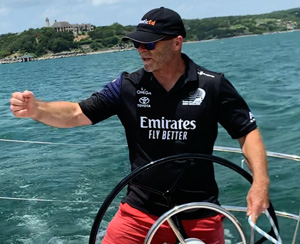
By Grant Headifen
NauticEd Global Director of Education
View Skipper Large Keelboat Course excerpt
Intensive coverage of the basic knowledge needed.
very good material for skipper and captain training.
Comprehensive. Wish I had done it years before. What a great course.
Everything best course ever.
This is a good comprehensive course. If you've done an ASA106 or US Sailing Coastal Passage Making, this will be mostly review. If you've done ASA104 or US Sailing Bareboat, there are still a few things to be learned here.
The detail in information.
The course was very detailed. I really felt I learned it lot. (I have taken several ASA courses, including Coastal Navigation, but this was much more demanding..which is good!
Very thorough and clear explanation of topics. Good influx of videos as well.
Well laid out.
Great, comprehensive review of key areas.
So much to delve into with all the VR and links to videos. I am so impressed by the work you put in to developing this course !
This was really long and comprehensive but exceptional every bit of the way. It provided a solid overview of not just knowledge but responsibilities and for that I am grateful.
Module 4 Rigging and Sails- Excerpt:
The following illustration shows the parts of the sail and associated control lines. Of note is the bolt rope which is one of the few actual ropes on a boat (another is the bell rope).
Click on a letter to show the name - click again to hide. Then test yourself.
Module 5 Rules and Safety- Excerpt:
In the video below, you can see two sailboats on a collision course. The sailboat on a port tack correctly changes course to avoid the sailboat on a starboard tack. The port tack boat also could have turned to starboard to duck in behind the other boat. However, in this case, it chose to tack. The decision to tack or duck is up to you.
Module 6 Slip Departures and Returns - Excerpt:
(3) Wind pushing into the dock and current from behind.
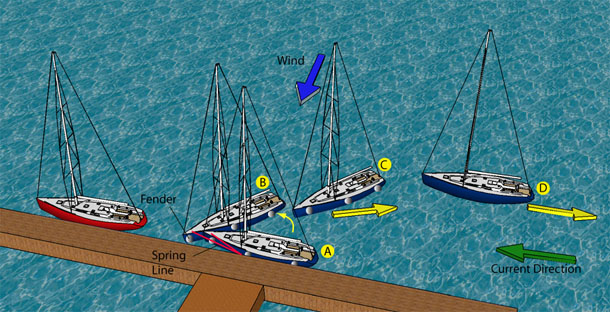
This is a little more tricky. If you try to go out forward the wind could potentially push you into other boats. Additionally, as you turn the wheel to head out, the rear of the boat will swing around towards the dock and other boats. therefore it is recommended that you reverse out using a spring line.
(A) Once you are confident in your plan,
(B) Once the boat has turned out from the dock, engage reverse and have your forward crew member release and retrieve the spring line.
(C) Continue backing out to be completely clear before engaging forward gear. Remember the rear of the boat will swing back towards the dock once you engage forward and turn the wheel to windward, so ensure there is plenty of room.
Module 7 Sailing - Excerpt:
Conversely, when you ask the wind to bend too much, the wind will spawn off creating turbulent airflow. This reduces the effect of the sails and slows the boat. The higher the velocity of the wind the less the wind tends to bend. This is one of the reasons why in high wind conditions you need to reduce the size of the sail. Since the sail is smaller when reefed, the wind is required to bend less over the distance from the front (luff) of the sail to the back (leech) of the sail and therefore the wind will not break away from the sail as much. Once the wind breaks away from the low-pressure side, as shown in the diagram below, you're reducing efficiency. In the same way, an airplane will stall. When the flow of air breaks away from the top side of the wing, the lift is lost and the plane quickly aims itself at the ground. In sailing, the result is less dramatic. Simply let the sail out and the wind will reattach to the leeward side of the sail.
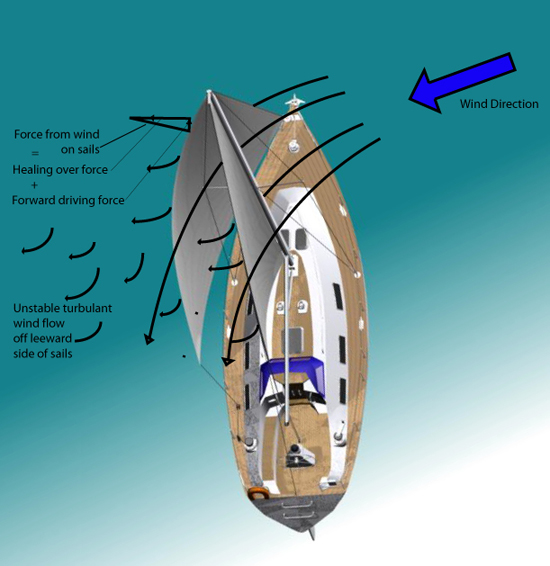
Module 9 Anchoring and Mooring- Excerpt:
Care must be given to swing. As the wind changes during the night, your boat will move with the wind and can put you into a precarious situation by being too close to the shore. Many times you'll find an anchorage area with moorings. Remember that boats tied to moorings swing less than anchored boats. In this circumstance, you may swing into other boats. The golden rule is "watch your swing".
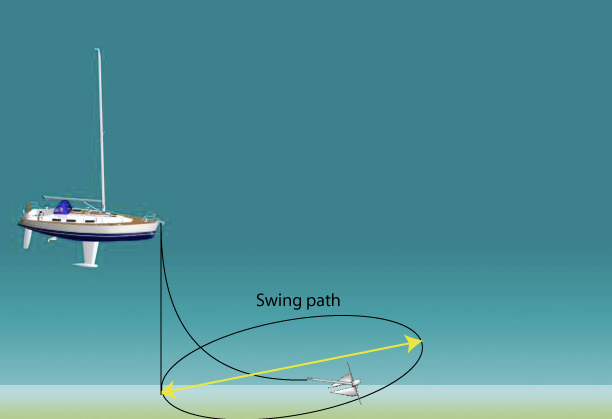
In addition, consideration must be given to the tide. As the tide "ebbs" out, you not only get closer to the bottom but your swing circle grows and the shore becomes closer. This diagram shows your swing path with deep water and the correct scope.
Module 10 Emergencies - Excerpt
Deep Beam Reach
THE TESTS
Each Module has associated with it approximately 20 test questions. Here is an example?
Q Who has the Ultimate right of way in this scenario?
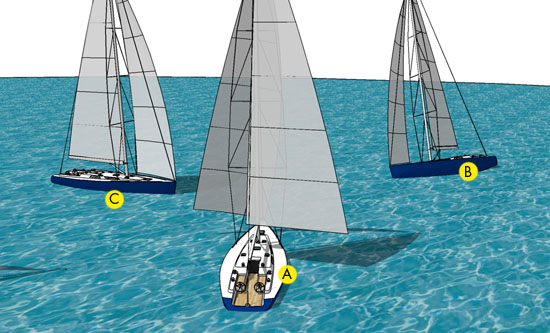
You will find the answer to this question in Module 5 of the Skipper Course.
Upon passing all the tests associated with each module, your NauticEd Sailing Certificate is automatically updated. This is not a USCG Captain's license. It is an acknowledgement that you have passed the NauticEd Skipper Course which is recognized by charter companies worldwide.
Other Courses you may consider are:
Free Basic Sail Trim Sailing Course
Qualified Crew Sailing Course
Get your sailing certification started now with the NauticEd Skipper Sailing Course.
I'd like to point out that I have had no formal sailing training, other than what our club provided. NauticEd was my main source of "class room" training and it was great! Can't wait to go chartering again and I will insist that our crew, on the next trip, take some of your courses!